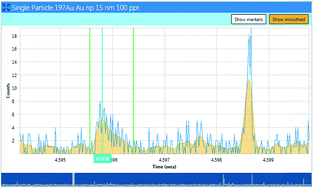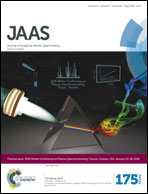Nano-particle analysis using dwell times between 10 μs and 70 μs with an upper counting limit of greater than 3 × 107 cps and a gold nanoparticle detection limit of less than 10 nm diameter†
Abstract
Inductively coupled plasma mass spectrometry (ICP-MS) is proving to be a useful tool for characterization and quantification of metallic nanoparticles. However, the short (200–400 μs) transient signals generated by single particle events have to date presented challenges to current instrumentation and methodologies. Minimum dwell times are available commercially at 50–100 μs timings but limitations in sensitivity for quadrupole ICP-MS make analysis of particles below 10 nm diameter difficult. A further limitation of ICP-MS when using smaller dwell times is the available dynamic range. Typically, a simultaneous detector as used with most ICP-MS has a maximum count ceiling of ∼3 × 106 cps which equates to only 150 counts for a 50 μs dwell. This work will present data acquired on a magnetic sector ICP-MS with GHz ppm−1 sensitivities using dwell times down to 10 μs and requiring no hardware modifications. This work will demonstrate the advantages obtained with the ability to measure fast transient signals with count rates in excess of 3 × 107 cps. A further range extension facility based on physical attenuation of the ion beam will be demonstrated which allows the same faster dwell times to be used for signals in excess of 1 × 109 cps. A novel data processing technique will be described, which overcomes the shortcomings of previous techniques when fixed particle signal widths and compliance with ideal Poisson statistics for error correction have been assumed. Data will be presented to show the non-ideal behaviour of ion cloud signals from nano-particles and the measurable impact of these behaviours on the calculations.

- This article is part of the themed collection: 2016 Winter Conference on Plasma Spectrochemistry

 Please wait while we load your content...
Please wait while we load your content...